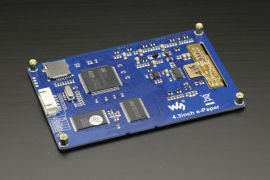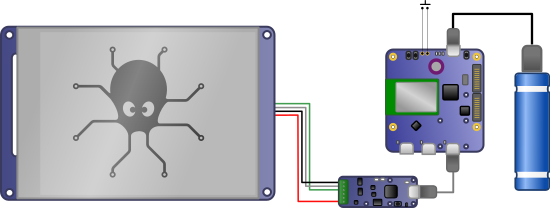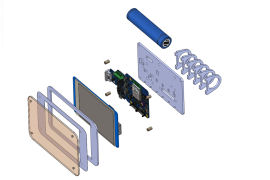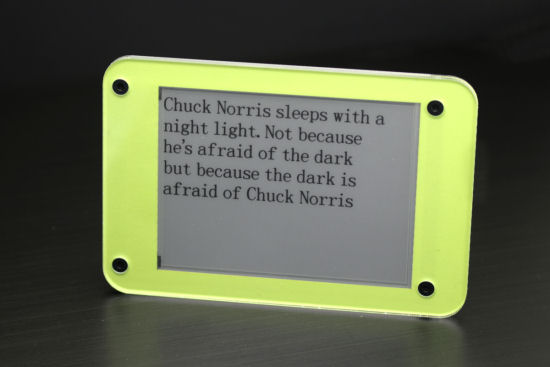![]() The issue with most screens is that they need to be constantly powered to display information. There is however an exception: the e-paper (or electronic paper) technology. This week, we take advantage of this technology to build a connected screen able to work for months on a single battery charge.
The issue with most screens is that they need to be constantly powered to display information. There is however an exception: the e-paper (or electronic paper) technology. This week, we take advantage of this technology to build a connected screen able to work for months on a single battery charge.
E-paper
The e-paper technology has some very outstanding characteristics:
- An e-paper screen stays readable in full light: this is particularly evident outside in sunlight.
- An e-paper screen keeps displaying information when it is not powered, and this opens some really interesting perspectives.

Readability in sunlight: why don't you try it with your smart phone?
Obviously, as nothing is truly magical in this world, there is a down side as well.
- As of now, this technology is mostly monochromatic: at best, you'll get a few shades of grey.
- No backlighting: these screens can't be read in the dark.
- Refreshing is slow, so much so that animations are hardly possible.
- Refreshing is not perfect: when they change state, pixels keep some of the previous state, provoking the apparition of ghost images. Therefore, most screens based on this technology perform a black-white cycle before the actual data update.
Nevertheless, there are numerous applications which can benefit from the advantages of e-paper while making do with the disadvantages. One of them is price display in store shelves. You only need an e-paper screen and an electronic component able to wake up, say once a day, to connect itself to a server, download the price to be displayed, update the screen if need be, and go back to sleep immediately. Such an electronic tag can work for months on end, maybe even years, with a simple battery.
This week, we built something quite similar... A type of electronic Post-It, remotely driven, and able to work for quite a long time on batteries.
A Yoctopuce display that consumes (almost) nothing
The hardware
It so happens that we found 4.3 inch e-paper screen manufactured by WaveShare. It features a 800x600 pixels resolution and can be driven in TTL series. It works with 5V or 3.3V.


The WaveShare e-paper screen
The idea is therefore to drive this screen with a Yocto-Serial, to drive the later with a YoctoHub-Wireless-SR, and to power everything with a small USB battery. The YoctoHub-Wireless-SR is configured to wake up at a regular interval, to connect itself with a Yocto-callback to a PHP script. This script updates the display and then turns the hub off. So the system is not powered most of the time. We added a small push button enabling us to wake up the system and to provoke a manual update. The Yocto-Serial powers the screen directly in 5V, which allows us to turn its electronics on and off as we want.

The contraption diagram
We put everything together with some acrylic glass panels, screws and spacers.



Our homemade e-paper screen
The software
The software part consists in writing a PHP script sending commands through the Yocto-Serial. We wrote a small PHP library which allows us to control the WaveShare screen. You can download it here with a script example using it to display a "Chuck Norris Fact" at a regular interval. With a small USB battery of about 2000mAh charged to the max, we managed to refresh the screen about 2800 times before the battery was completely empty. If you assume about 10 refresh cycles per day on average, you can hope to last about nine months on a single load. And here is the result:
About the WaveShare screen
The screen that we found is relatively cheap, but it has several limitations that you must be aware of if you don't want to be too disappointed when you use it. Here are a few of the issues that you are going to cross:
- The screen goes blank automatically as soon as you power it. It's an unfortunate choice from WaveShare but it's something you can easily work around: as it is powered by a Yocto-Serial, you can power the screen only when you want to update it. But then you find yourself with a double refresh cycle instead of a single one.
- The number of draw primitives is rather limited: dots, lines, circles, rectangles, triangles, filled or not, just one single line thickness. There is only one font available, and only in three sizes.
- Bitmap images must be loaded on a micro-SD card before they are displayed. It seems that you can't send an image directly on the screen from the serial port.
- Don't count too much on the WaveShare support. We asked them some relatively simple questions three weeks ago and we didn't get any answer.
Conclusion
When you have only a small amount of energy available, e-paper is an excellent way to display a piece of information that doesn't change too often. We don't expect you to have store shelves at home and we guess that "Chuck Norris Facts" entertain you only so much. However, if you need a system to leave a message to someone that you can't contact directly, it's an attractive solution.


